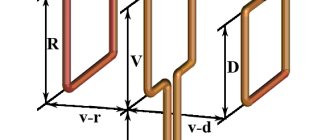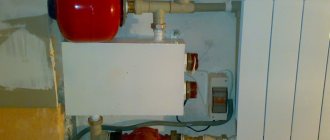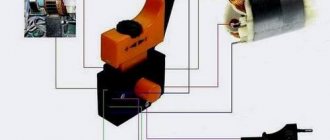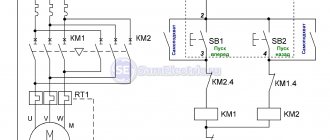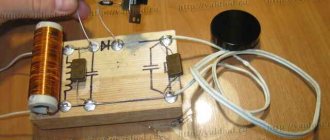If you are doing home renovations yourself, sooner or later you will be faced with the fact that you will have to make grooves for electrical wiring.
For this, a special tool is used - a wall chaser. True, buying it can cost you a pretty penny.
If you need to save money, we can offer an alternative option - make an attachment for the grinder for grooves
.
In fact, a homemade product is not very different from a factory wall chaser.
The homemade attachment also allows you to change the distance between the discs, and also has a pipe for connecting a vacuum cleaner. Well, making the device is not at all difficult.
Using an angle grinder
, you can make grooves in walls made of aerated concrete, as well as in reinforced concrete walls and brick partitions.
To make a homemade wall chaser, not only an angle grinder is used. You can also use a hand router or electric drill as a basis.
In today's article we will look at several options for homemade devices:
- -yourself wall
-cutter attachment ; - wall chaser from a hand router;
- manual wall chaser for cutting aerated concrete blocks for reinforcement.
Using a wall chaser you can also cut out seats for socket boxes.
Usually a hammer drill with a diamond crown is used for this, but if the walls have been plastered recently, the slotting mode can lead to the formation of cracks on the wall surface.
If you do not have the opportunity to make a homemade attachment for an angle grinder ( wall chaser for an angle grinder
), and there is no hand router available, you can use a simpler method - make grooves using an electric drill and a drill.
This method will take much longer, but when there are no other options, it will do.
Well, now let's move on to making homemade devices. First, let's look in detail at how to make a wall chaser from an angle grinder with your own hands.
.
To make some parts we will need a lathe. However, you can ask a familiar turner for help. Or, perhaps, someone will have ready-made parts of the required shape and size.
Design and operating principle
Wall chasers come in several types: manual and electric.
Manual
Hand tools usually have a curved or simply straight handle. The wall chaser with a straight handle has two convenient holders, which are necessary for cutting straight and even grooves on vertical walls.
The curved handle furrower also has two convenient holders, but it also has a double-sided cutter, tightened with a bolt. This hand tool is used to create grooves of the required depth and size in horizontal construction surfaces.
Factory-produced manual wall chaser
Electric
This is a powerful tool that has two rubber rollers that help the wall chaser move easily along the wall surface being processed. This furrower is equipped with comfortable handles and several cutters that move thanks to a built-in electric motor. Designed for cutting grooves in various hard building materials.
This is a fairly simple construction tool, but its use requires certain skills and experience from the master. Also, when working with power tools, you should remember to wear personal protective equipment, as they create a lot of construction dust and noise.
Factory-produced electric wall chaser
Types of instruments
In most hardware stores you can see two types of wall chasers:
- manual wall chaser for aerated concrete;
- wall chaser on an electric motor.
One of the differences between these types is their cost and, of course, functionality, but their purpose is absolutely the same. Unlike electric wall chasers, manual ones are not as easy to use, and their productivity is slightly less. Due to this, the cost is much lower.
An electric tool is more effective than a manual one, but the price is not affordable for everyone. Basically, a wall chaser with an electric motor is used for the construction of large-scale structures and structures, for example, high-rise buildings, all kinds of complexes, and so on.
In order to figure out exactly what type of tool is needed, and what is their difference, it is necessary to study each of them in more detail.
What type of device can you make yourself?
You can make a wall chaser or furrow maker yourself if you have a certain tool and the necessary materials. So, for example, a hand tool can be welded from an ordinary water pipe or metal fittings. An electric furrower can be made from an angle grinder or drill, with some modifications to these two tools.
But it is always necessary to keep in mind that the manufacture of electric tools in handicraft conditions is not always justified, since there are few grooves to be made in the house, and the manufacture of a complex electric wall chaser will take a lot of time. In ordinary walls, you can make grooves with fittings or a thick metal plumbing pipe.
To cut aerated concrete, it is best to use a grinder converted into an electric wall chaser. We will look at all stages of work in step-by-step instructions on how to make hand and power tools at home.
Grooving grooves in aerated concrete
For aerated block walls, the simplest and most effective way to install hidden utility lines is gating. The grooves made in the wall must ensure reliable installation of electrical wiring or plumbing without compromising the strength and stability of the structure. When planning a routing, several mandatory requirements must be met:
- grooves must be laid only in a vertical or horizontal direction, diagonal laying is not allowed;
- the length of the channel should be no more than 3 m;
- the width and depth of the grooves must ensure tight laying of the cable or pipe, without unnecessary gaps, and their size should not exceed 25 mm;
- the distance of the channels from doors, windows, ceilings must be at least 15 cm.
Before starting work, you need to develop a plan for routing hidden communications taking into account the specified requirements, mark it for gating on the walls and save the plan for repairs if necessary.
Grooving aerated concrete.
In addition to hidden communication wiring, gating is also performed when installing walls made of aerated concrete blocks to install an armored belt between the tiers of the wall. These works are mandatory, so when building a house made of aerated concrete it is impossible to do without gating, and its implementation requires special tools.
Step-by-step manufacturing instructions
Tools and materials
To make wall chasers we will need:
- Fittings or water pipe;
- Welding machine;
- Bulgarian;
- Drill;
- A metal sheet;
- Two diamond circles.
Drawings and diagrams
Hand made wall chaser.
Do-it-yourself manual wall chaser made from scrap metal
Electric wall chaser from a grinder
Wall chaser made from an angle grinder with a casing
Electric wall chaser made from an angle grinder with a dust extractor
Electric wall chaser made from an angle grinder with a dust extractor from a vacuum cleaner
Step by Step Actions
Making a manual wall chaser from scrap metal
- The most common furrower can be made independently from a simple piece of water pipe or thick metal fittings.
- To do this, you need to take a piece of pipe with a diameter of 2–3 cm and measure approximately 5–7 centimeters from one side.
- In this place, you need to make a cut with a hacksaw or grinder at an angle of approximately 45C, but without cutting the pipe to the end.
- Then you need to bend the top of the pipe so that you get an acute angle. Thus, we have made the simplest tool that can be used to make grooves. Its smallest part is a working tool, and the largest part is a handle.
- You can put a piece of rubber hose on the handle to make it comfortable to work without rubbing your hands.
Manual wall chaser made of metal pipes
From reinforcement
- A more complex and convenient tool can be made from two pieces of reinforcement or an ordinary metal pipe.
- To do this, we need to take a welding machine and use it to weld pipes or fittings into a single whole, so that one piece is approximately in the middle of the other. The handle must be made from a thicker piece of reinforcement for more convenient use of the tool.
- A small piece of ordinary metal pipe, approximately 10–15 centimeters in size, will perform the working function of the tool. To do this, the edge of the pipe must be cut so that an acute diagonal angle is obtained.
- Once you weld a short tube to the edge of the finished handle, you'll have a handy hand tool. It is completely safe to use and therefore can easily be used to make grooves and furrows in the walls of houses.
- Also, if necessary, you can put a piece of soft hose on the handle, which will protect your hands while working.
Manual wall chaser, made with your own hands from a metal pipe with a round and square cross-section
Video: how to make a manual wall chaser with your own hands
Electric wall chaser from a grinder
An electrical device made independently may not be entirely safe, since many craftsmen, when making wall chasers at home, do not strictly adhere to safety precautions.
But, if you still decide to make such a tool yourself, then for this you will need a grinder (angle grinder) and two diamond wheels for cutting building aerated concrete and ordinary concrete. You will also need a nut for careful fastening.
Grinder and two diamond wheels for making a wall chaser
- The first disk (circle) is placed on the tool and tightened well with a special fastening nut.
Installing the first wheel for a wall chaser - The second diamond disc is placed on top of the first and is also tightened well with a nut.
But for the second circle you will need a special bushing, a long nut, washers or other fastening elements. Installing a second diamond wheel on an angle grinder - If necessary, you can install various washers to cut grooves of the required width.
How does a wall chaser made from a grinder and two diamond wheels work?
If the grinder does not have sufficient threads to attract two diamond discs, then you should not make a wall chaser, as this can be very dangerous for your health. In this case, you can simply use a metal ring of the same diameter, but much smaller in width. You can also take a set of washers. This is very convenient, since you can choose the width of the future furrow depending on the cross-section of the cable.
Video: wall chaser from an angle grinder for cutting aerated concrete
Electric wall chaser with housing
Since the previous version based on an angle grinder will work without protection, all the dust will spread into the room, and thus the work will deteriorate. In this case, you can make a more innovative furrow maker with a protective, safe casing.
- In order for the dust to instantly disappear during operation, you need to equip your grinder with a vacuum cleaner.
Its hose must be firmly secured above the cutting part of the tool so that it picks up a cloud of dust. Wall chaser made from an angle grinder with a protective casing and outlet for a vacuum cleaner hose - Since the disk on an angle grinder rotates backwards, the suction structure must be installed on the rear of the casing.
Then, using ordinary clamps, the vacuum cleaner tube can be secured to the grinder so that it does not interfere with the normal rotation of the circle. Wall chaser with a hose from a vacuum cleaner for removing dust - Also, the vacuum cleaner mechanism must be secured to the homemade tool so that it can be held comfortably and firmly in your hands while working.
- To use a wall chaser you will need two sockets to turn on the grinder and vacuum cleaner. Thus, you get an excellent groove cutter for cutting aerated concrete and other durable building materials for the construction of walls where grooves for electrical wiring and other utilities need to be made.
Manual wall chaser
If using an electric wall chaser is not practical, you can use a manual analogue. This type of device is a suitable option for small private buildings, since its cost is much lower.
An indisputable advantage is the fact that the manual type of the device is almost silent. It is not as dusty as electric. This product consists of a metal pipe, and handles are attached to the side. On one side of the pipe there is a cutting part that cuts into the aerated concrete mechanically.
In the construction industry, there are two types of manual wall chasers:
- devices that are used on horizontal surfaces;
- for processing vertical surfaces.
Both options are used for the same purpose. Their differences are only in the shape and location of the elements on the base that make up the tool.
A manual wall chaser for horizontal surfaces is equipped with a curved handle. While for a tool for vertical processing, this handle has a flat shape. These types of handle shapes are specially created. In order to be able to process the surface as best as possible without much effort.
Dust removal
Working with two diamond wheels at once creates a large amount of dust. This significantly affects the work process. Therefore, an integral part of the wall chaser casing is the presence of a pipe for dust-free work. A mandatory element when cutting channels is the presence of a construction vacuum cleaner connected to the pipe.
Here is one example of a homemade vacuum cleaner:
Branded wall chasers often come complete with vacuum cleaners. In this case, you don’t have to think about matching the technical characteristics of the power tool with the performance of the vacuum cleaner.
It is difficult to perform high-quality dust extraction in a homemade wall chaser, but it is possible. However, its significant reduction is an important step towards ensuring normal working conditions.
Electrical appliance
This type of tool is universal because it easily copes with its main purpose; it is excellent not only for aerated concrete, but also for other, more dense building materials. Using such a wall chaser you can work, for example, with materials such as reinforced concrete, brick, cement mortar, etc.
When working with an electric wall chaser, aerated concrete or other building material is cut using diamond wheels. A pair of special disks, which are located at the same level, are the working link of the tool. The width of the slot is equal to the gap between these working disks, and the depth can be adjusted depending on how deep the disks go inside the material being processed.
It is worth noting a certain feature: a working electric wall chaser emits a considerable amount of dust during the processing of the material. In this regard, during the process of wall gating, it is recommended to immediately remove dust using an industrial vacuum cleaner. As already mentioned, a tool with an electric motor is a profitable option for the construction of large-scale buildings. For the purpose of building small buildings, for example, dachas or private houses, using this type of device is impractical and unprofitable. Another nuance is the fact that during cutting the device makes quite a loud noise. This is primarily due to the presence of an electric motor. In addition to this, discs cutting into aerated concrete produce additional noise. In this regard, it is better to use this type of device during construction, and not during repair or reconstruction, when the building has already been put into operation.
Nuances of processing aerated blocks
Typically, the following tools are used for processing aerated concrete:
- chisel with hammer;
- hammer drill with a special attachment;
- grinder with a disc for concrete.
Some of the above will probably be found in every owner’s workshop. But high-quality processing of gas silicate cannot be performed with these tools, since they are not intended for such work. Problems encountered:
Handicraft methods of gating have low productivity. The result is low quality of work performed and a lot of wasted time. Careless handling of a chisel can even result in additional repairs to the wall or its complete restoration.
Safety regulations
If you want to make such a unit yourself, you will need a lot of time, some knowledge, practice, and manufacturing instructions. Before work, weigh everything carefully: is it worth starting, will the money spent pay off? Ask your friends, other builders who have experience making similar tools, whether it is profitable.
If you have the desire, then creating a wall chaser yourself is quite possible. The main thing is to adhere to manufacturing rules and remember safety precautions.
Return to contents


